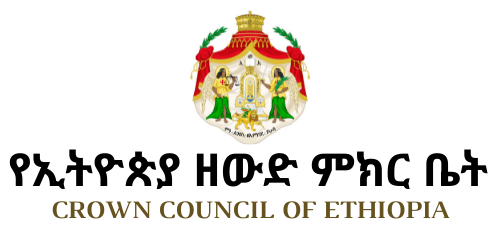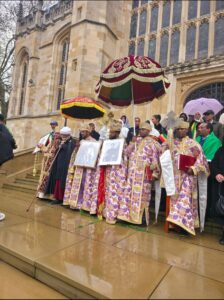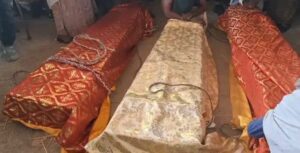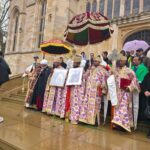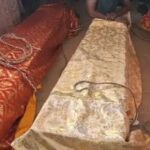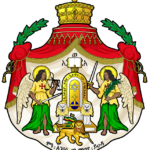Published by The Imperial Society of St. George of Lalibela, Copyright © 2004
FOREWORD
His Imperial Highness Prince Ermias Sahle-Selassie Haile-Selassie
President of the Crown Council of Ethiopia
Ethiopia is a beautiful mosaic of cultures, faiths, and many lifestyles. It is the home of Christians, Muslims, and Jews, as well as those of various traditional beliefs. Ethiopia is also a land of amazing beauty. Our mountains, valleys, and rivers are a wonder to behold. God and nature have richly endowed our country, that even visitors feel an inexplicable spirituality while there.
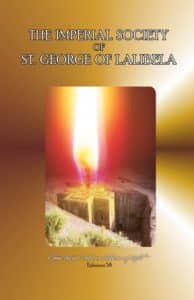
Ethiopian civilization represents the longest unbroken chain of cultural continuity in the history of the world. The rift valley is the home of Denkinesh – who is known to the world as Lucy – the earliest humanoid, and thus, the cradle from where human society first emerged. Ethiopia is also a country that is the custodian of the Ark of the Covenant. The worldwide Christian community considers Ethiopia as an illustrious realm mentioned in the Bible more than 40 times. Furthermore, our country is world renown as the land where the Solomonic Dynasty of the Ethiopian Crown had served at the helm of Ethiopian society for centuries. The Prophet Mohammad called Ethiopia “the land of righteousness” and ordered his followers never to provoke Ethiopia. Thus, as there is a direct link between Ethiopia and the biblical world of Jews and Christians, so is there a direct link between Ethiopian society and the very foundation of Islam. Ethiopian civilization is, therefore, a world treasure of great importance, as it is the root of Judeo-Christian civilization as well as the fabric of Muslim society.
Ethiopia is a country that has withstood the ravages of periodic war, famine and revolution. Our people fought gallantly the Italians at Adawa, and Machew, to uphold the dignity of people of African heritage which made Ethiopia the source of African identity and the beacon of African Independence. At the inauguration ceremony of the Organization of African Unity, H. E. President Julius Neyrere stated that Africans who had previously accepted European domination as a given, learned from Ethiopia that it is possible to fight, and even to win the fight!
Ethiopian culture is a relic of ancient times and at the same time alive and vibrant. It has been, and continues to be enriched by its diverse heritage, which has made it full of promise, and great potential. Ethiopians in the Diaspora have transplanted our rich cultural heritage to help us maintain our identity, and to sustain us in our new home of refuge. In return, we have all learned, and gained tremendous experience living in all corners of the world – from London to Sydney. If encouraged and accepted, we can utilize our human and material resources to help modernize our country.
The preservation of Ethiopia’s cultural heritage and the transmission of its oral history and customs, were threatened with annihilation by the violent tidal wave of the 1974 coup d’etat and the Dergue’s subsequent purges and genocidal acts. After this wave receded, and the global Cold War had ended, another wave – this time of globalization – began to wash over the world, including Ethiopia, before our country could regain its sense of identity and restore its damaged treasures. Thus, I believe that the church and the Crown Council, together with other concerned groups, have the responsibility to put back the pieces in the mosaic of history, so that Ethiopia can continue to play its intrinsic role in the world community.
Dear readers, I have narrated facts which are well known to most of you, to express the immense pride and love that I have for my country. These facts are also reiterated as a backdrop to show what has inspired me and members of the Crown Council to change our focus from the realm of politics to cultural preservation, environmental conservation, social development and humanitarian programmes, which are the overriding needs of our society. It is, indeed, my deep concern for my country, and my sincere belief that the Solomonic dynasty has the historic responsibility and moral obligation to be of continued service to the Ethiopian people, that has helped me to translate my dream into viable programmes. In this way, the Crown will continue to be of service to the Ethiopian people.
The plan to establish the Imperial Society of St. George of Lalibela was first conceived in 1994, a year after HIM Ameha Selassie reconstituted the Crown Council in Exile, and appointed me as its Chairman. The work of the Society was, however, launched on July 24th, 2004. The delay in initiating the work was due to many factors. Those of us who were appointed to serve on the Crown Council needed time to familiarize ourselves with the tremendous responsibilities that were entrusted to us. Since we assumed our posts without any financial backing, and we had to at the same time earn our living, volunteers had to be found to help us initiate some projects that are relatively self contained and did not require most of our time, such as the Scholarship Programme granted to 24 Ethiopian Students by the Pacem In Terris Programme, of La Roche College, Pennsylvania. Priority was also given to first support development programmes.
The success of the Scholarship and other Programmes implemented by the Haile Selassie Fund for Ethiopian Children, the warm reception that I received during my brief return to Ethiopia in the year 2003, had convinced me that the Ethiopian Imperial family still has an important nonpolitical role to play in Ethiopian affairs. With this in mind, we registered a branch of the Haile Selassie Fund for Ethiopian Children in Addis Ababa, Ethiopia, in May 2004.
The overriding Cultural Role of the Crown Council is to promote reconciliation, peace building, and national unity. While the Haile Selassie Fund for Ethiopian Children will support environmental conservation, social development, and humanitarian programmes, the Imperial Society of St. George of Lalibela will give support to preserve Ethiopian History, uphold Ethiopia’s religious heritage, and maintain the history and dignity of the Crown. These programmes were formulated to be complementary, so that they may jointly carry forward the legacy of HIM Emperor Haile Selassie I, who was in the frontline in preserving Ethiopia’s ancient heritage, and at the same time, in modernizing his country.
The launching ceremony of the Imperial Society of St. George of Lalibela, and the commemoration of the 112th Birth date of HIM Emperor Haile Selassie I was organized together with the Annual Meeting of the American College of Heraldry, on July 23-24, 2004, at Charleston, South Carolina. This booklet records the events that took place before and during the launching ceremony. It also shows some samples of Ethiopian heritage that need to be preserved. The samples presented were used because they are conveniently available for publication. The aim of the Society is, however, to promote that every cultural heritage in Ethiopia be given equal recognition and that they also be well recorded to help maintain the dignity of all the people in the country.
One of the objectives of this booklet is to explain in full the purpose and goals, as well as the structure, of the Imperial Society of St. George of Lalibela, to help introduce the Society to the worldwide public. It will also serve as a guideline for the members of the Society who wish to establish Chapters in other States in the US, and in other countries around the world. As membership in any viable Society should be a dynamic one, the content of the booklet is only a foundation on which the members can build. The members should expand the objectives of the Society, if and when needed, so as to ensure the achievement of its goals at all times.
The cultural heritage of different linguistic groups in Ethiopia will be presented at each annual meeting of the Imperial Society in the US. We hope that this will promote further understanding and appreciation of each other’s cultural heritage, and thereby strengthen national unity. Furthermore, the members of the Society will be encouraged to find support for preserving indigenous cultures which have hitherto been neglected, and/or not sufficiently recorded. The use of modern technology to record and preserve oral history, ancient poetry, and songs will thus be supported.
The major raison d’etre of the booklet is to show that the true history of a nation includes the history of all the people in the country; the major contributors to the well-being and dignity of the nation; all religions practiced in the country; as well as that of all Monarchs of different lineages, and of other leaders who have served at the helm of Ethiopian society. Thus it embraces the entire population of Ethiopia and promotes an inclusive sense of national unity. This has been, and will continue to be, the role of the Ethiopian Crown.
Furthermore, it is intended that the booklet should serve as an educational tool to teach all Ethiopians – particularly the younger generation – that Ethiopia has an ancient heritage in which all its people should continue to take pride. The people also need to be made aware that it is the nation’s dignity and honor, derived from our ancient heritage, that had enabled succeeding generation of Ethiopians to weather the storms of frequent war and famine.
In addition, the booklet is used to transmit important messages of deep concern related to upholding the nation’s ancient heritage. It alerts our people to alarming erosion of our country’s long-established culture of tolerance, and coexistence of many linguistic and religious groups. It emphasizes the moral obligation of the educated groups to share their knowledge with their fellow countrymen, and to provide effective leadership at all levels of society. The need to involve the beneficiaries in planning and implementation of projects designed to alleviate their problem is also emphasized. Furthermore, by outlining the value of Ethiopia’s historical heritage, we hoped that the booklet will encourage Ethiopians to be more involved in cultural preservation.
One serious matter that I am deeply concerned about, and that should concern all the people of Ethiopia, is the ongoing pillaging of historic documents and artifacts. The archives of various national institutions are being emptied, and invaluable documents and artifacts are sold in the streets of Addis Ababa and other towns, leading to erosion of Ethiopian history. Thus, I call on educators at all levels, including members of the press and radio, to join hands with us to inform the public regarding the danger of such practice.
The design of the front cover of this book was prepared by two brothers, Ermias and Endrias Hailu Zewede, who received their University education in the US through the Scholarship Programme granted by the Haile Selassie Fund for Ethiopian Children. It depicts the dream which I actually had in which I saw the border of the Church in Lalibela illuminated by three rows of candles. In preparing the design for the booklet, it was, however, decided to use only one candle for aesthetic purposes.
May we all “Walk as the Children of Light.”
Prince Ermias Sahle-Selassie Haile-Selassie, Co-Patron of The Imperial Society
